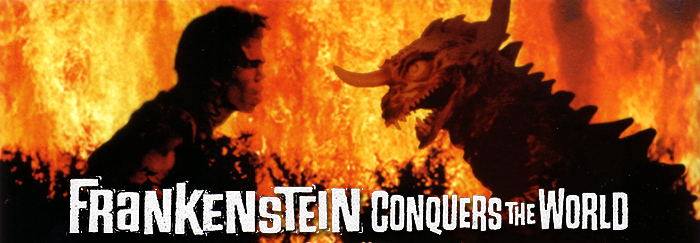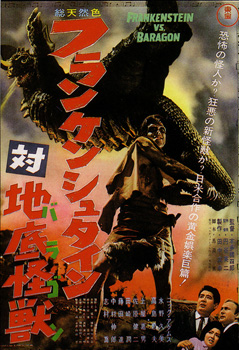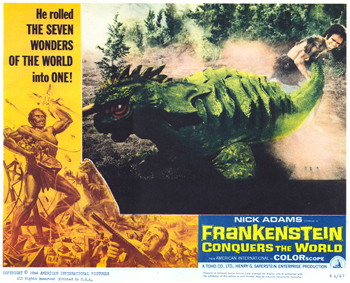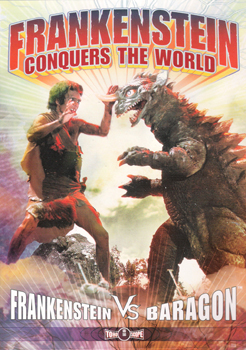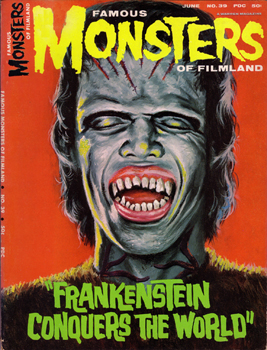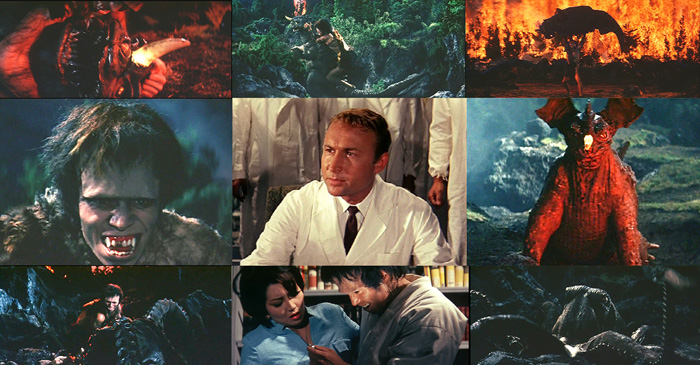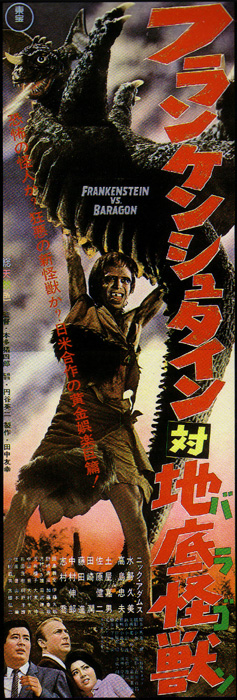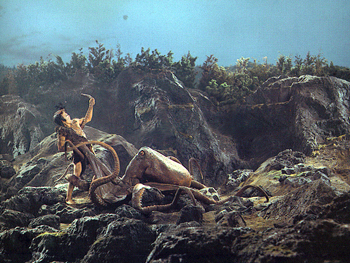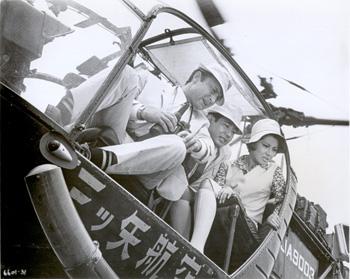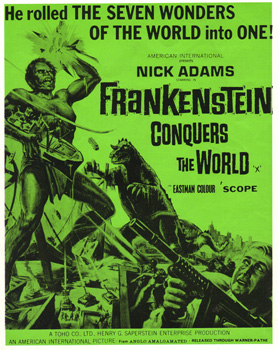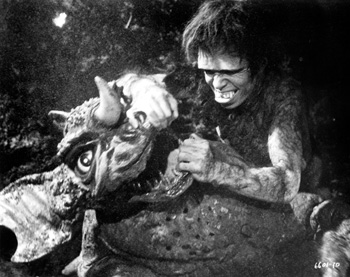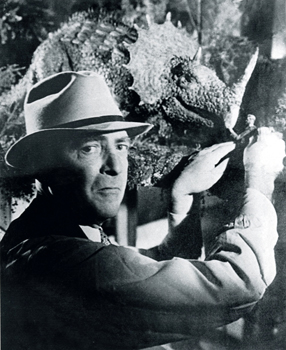Double Disc Dose of FRANKENSTEIN CONQUERS THE WORLD Author: Bob Johnson Source: Media Blasters Special Thanks to Richard York, Clay Holden and Loren Portillo
- Mysteries Revealed! A Look Back at FRANKENSTEIN CONQUERS THE WORLD
- How King Kong and Frankenstein Came to Japan
Before his death, stop motion wizard Willis O’Brien penned a story called "King Kong vs. Frankenstein". The story ended up going through a number of hands, and a number of changes, before coming to rest at Toho in Japan, which was responsible for the final incarnation that became KING KONG VS. GODZILLA (King Kong tai Gojira – 1962). Kong would go on to star in another Toho film KING KONG ESCAPES in 1967.
Toho did not let the Frankenstein legend rest for long however, and in 1965 produced the first of two films that would take a very different approach than the general Toho fare at that time. FRANKENSTEIN CONQUERS THE WORLD (known as FRANKENSTEIN VS. BARAGON or Furankenshutain tai chitei kaijû Baragon in Japan) opens with the heart of the Frankenstein monster confiscated from a German lab by Nazi troopers during World War II. Mysteriously turned over to the Japanese military. The heart is taken to a lab in Hiroshima, but is then lost when the U.S. atomic bomb falls on the city. Twenty years later a strange boy shows up and is taken in by doctors James Bowen (Nick Adams), Sueko Togami (Kumi Mizuno) and Yuzo Kawaji (Tadao Takashima). It is theorized that the boy grew from the regenerative tissues of the Frankenstein Monster’s heart. As the boy gets larger and larger, outgrowing the confines of the lab and later a specially built cage, he escapes and heads for the forests where he hides and forages for food. Meanwhile the subterranean monster Baragon appears and attacks an oilrig. He then comes to shore and crushes a mountain villa full of revelers. This eventually leads to the final showdown between the two titans, one of the longest and more brutal fights in Toho kaiju history. The movie was a co-production between Toho Co., ltd. and Benedict Pictures. The two versions released in the U.S. and Japan differed in structure and content. An alternate ending, which was not used for either release was also filmed, in which the Frankenstein monster unexplainably battles a giant octopus in a nearby lake. The film was released on laserdisc in Japan with the alternate ending included, as well as deleted scenes and trailers. Later released on DVD, a gallery of Toho lobby cards from the movie was added, as well as a scene comparison between the Japanese and U.S. versions of the film. It also included an audio commentary by Sadamasa Arikawa, who was the Chief Cameraman at the time. The alternate ending was offered as a branching option on the DVD, with viewers being able to select which ending they wanted to see.
In 2007, Media Blasters released their DVD of the movie and has gone the extra mile with this fine set. All the extras from the Japanese DVD are ported onto this release, including a subtitled version of Arikawa’s commentary, in which he details many of the special effects scenes and camera angles. He also discusses what he can of the actors and other scenes he was not directly involved in. His insights though are quite interesting and informative. Rather than offer the alternate ending to the film as a branching option, Media Blasters opted for a two-disc set which includes three full versions of the movie. The U.S. release with the original English dub, the Japanese theatrical version and the “international version” which includes the alternate ending, both of which are in Japanese with optional English subtitles. Arikawa’s commentary is on the theatrical version of the film. SciFi Japan asked Richard York of Media Blasters about the branching option on the Toho DVD and why it was not used on the US disc. His explanation was, “Branching can be problematic on some DVD players, making for a less-than-smooth transition. I think most modern DVD players can handle it but we check our discs on a variety of players and see how they perform and behave. When discussing this with our DVD author, Dave Beinlich, we thought it would be very possible to just do two complete versions instead of trying to be tricky with branching and possibly disrupting someone`s viewing experience”. The image gallery is much more extensive than the Toho DVD`s is. It includes the Japanese lobby cards from the Japanese release, but also goes on to show stills, posters and lobby cards from various releases around the world for a total of 97 images!
According to Ricard, “The primary difference between our DVD and the Japanese DVD was that we`d be including as much U.S./English language materials as we could get, primarily the English dubbed version. Plus we were able to get a lot of great gallery goodies from Ed Godziszewski`s collection that were not on the Japanese DVD.” The U.S. version of the movie, although shown quite a bit on television over the years, has never had an official release on video in this country. At first it was not known if a descent print of the dubbed film would be available. Richard recounted the steps Media Blasters had to go through to produce a presentable version of the English dub. “We knew we would be including the English dub and got the TV master from MONSTERS HD, which was 1.78:1. When this info got out, there was a lot of grumbling about the aspect ratio not being 2.35:1. So we looked at our options. We could use the 1.78:1 TV master as is, or we could see if it were possible to marry the English audio with the available 2.35:1 print used in the Japanese version. I did a side-by-side comparison of the 1.78:1 US version and the Japanese version to see if they matched up. And they did, in as far as all footage in the TV master was available within the 2.35:1 Japanese version. So we were able to faithfully recreate, frame-by-frame, the TV master in the 2.35:1 aspect ratio. (The 2.35:1 English opening credits were taken from the MONSTERS HD TV master, which presented the credits in 2.35:1, before going to 1.78:1 for the feature). Alternate scenes seen in U.S. TV versions are only available in the full-frame, VHS-sourced footage found in the deleted scenes extra. I know this is disappointing for some but widescreen versions of those scenes apparently do not exist, and providing a full-frame video presentation was not an option.”
With past DVDs from Media Blasters, the movies were pretty much presented in versions mirroring the Toho DVD release, with English soundtracks added. This is the first Toho release in which Media Blasters went above and beyond the Japanese release to give fans a true gift, full of extras and complete versions of all three releases of the movie. FRANKENSTEIN CONQUERS THE WORLD was followed a year later by a sequel, WAR OF THE GARGANTUAS (Furankenshutain no kaijû: Sanda tai Gaira) in which the brown and green gargantuas are believed to have grown from cells of the Frankenstein Monster, one in the ocean, the other in the mountains. Although Media Blasters does not have the rights to release the follow-up, Classic Media has announced their DVD of WAR OF THE GARGANTUAS for 2008. The two DVDs, although released by separate companies, should make a nice set and give viewers a great look at two Toho kaiju films that broke the mold of men in suits in favor of make-up and costumes. When asked about the acquisition of FRANKENSTEIN CONQUERS THE WORLD, Richard responded, “I`m not involved in the acquisitions of titles, but I can tell you that Media Blasters was founded on Japanese cinema and anime. And over the years, we`ve developed excellent relationships with Japanese film companies. When we first started releasing Toho films (early `05 with THE MYSTERIANS), they were very successful. And people began bombarding us with requests to release FRANKENSTEIN CONQUERS THE WORLD. I`m not privy to the rights situations, but once it became available to us, we snatched it up”. Lucky for us that they did! These two movies were a high-point in the golden era of Toho kaiju films and should not be missed in their U.S. releases. Keep an eye on SciFi Japan for information on Classic Media’s upcoming releases!
Mysteries Revealed! A Look Back at FRANKENSTEIN CONQUERS THE WORLD Author: Richard Pusateri Toho Co, Ltd. made a lot of strange movies, but FRANKENSTEIN CONQUERS THE WORLD holds the world class heavyweight title for bizarre movies. FCTW is an emphatically mysterious movie that begins in confusion and ends abruptly, or absurdly depending on which ending you’re watching. The title is strange because the Frankenstein monster of FCTW was a confused, frightened teenager who couldn’t even conquer a bird or wild pig, much less The World. Actually, Toho’s Frankenstein monster doesn’t prevail against anything, beside the occasional pet dog or rabbit, until the final scene.
There are many unanswered questions about FCTW from beginning to end. The origin of the titular monster (the mutant descendent of Dr. Frankenstein’s creation) is never specifically ascertained in the film. Perhaps the viewer is allowed to decide if the monster was regenerated from the original monster’s irradiated heart or did one of the starving “Orphans of Hiroshima” eat the heart? (Or was the “boy” really the regenerating monster and mistaken for a war orphan?) Possibly, the producers intended multiple contradictory creation myths to be operational or at least coexist as in the original Godzilla movie. The recent Media Blasters DVD release has English subtitling that puts the weight on the heart-regeneration theory. Everything we learn about the self-restoring nature of the monster’s body parts leads the viewer to conclude that the heart grew itself a new body. Also, the regeneration theory vaguely links FCTW to its follow-up WAR OF THE GARGANTUAS. Mysteriously, the monster’s face has Asian characteristics even though it is described as “distinctly Caucasian” and besides, a German heart would grow a German body, wouldn’t it? Logically, I mean? Other questions develop such as, where did the monster find size XXXXXXXL pants and shirt to wear or how he became amphibious during his party boat-threatening appearance the in the ocean. There are many conflicting accounts of genesis and production of the original Japanese movie FRANKENSTEIN VS BARAGON (Furankenshutain tai Baragon or Furankenshutain tai chitei kaijû Baragon) and the U.S. version FCTW. Executive Producer Henry G. Saperstein gave interviews that seemed to contradict other sources. Japanese language texts do not agree on certain points, but most sources seem to agree that this was the first Japanese and American co-production of a Toho special effects movie. Even what is on the Japanese VHS and laserdisc releases is not well-understood in available English language material. The Media Blasters DVD two-disc set appears comprehensive, but still mysteries remain. Most of the truly fantastic elements of the story begin to unfold after twenty minutes of grim and less-than-entertaining social realism, specifically pertaining to World War II and the atomic bombing of Hiroshima. Several parts of the early story are based on real events that were little known or forgotten in the United States. Radiation poisoning, starvation and war orphans are explicitly depicted before the strange dog-eating child begins to grow into the giant Japanese Frankenstein’s Monster. The shift from almost solemn reflection on the horrors of modern warfare to a slapstick comedy monster movie is attributable to the script that was stitched together from several disparate sources, almost like Frankenstein’s monster itself. Three writers (Takeshi Kimura (billed as Kaoru Mabuchi), Jerry Sohl and Reuben Bercovitch) are credited respectively with screenplay, synopsis and story. It isn’t far-fetched to presume Toho staff writer Shinichi Sekizawa, director Ishiro Honda and executive producer Henry Saperstein also had some input. The origins of FCTW go back to an idea to graft the Frankenstein legend onto a Japanese science fiction movie in a scenario by Shinichi Sekizawa titled "Frankenstein vs. The Human Vapor". No movie ever developed from that idea, but it shows that Mary Shelly’s literary creation was on Toho’s radar. Around the time from American John Beck sold Toho the treatment for “King Kong vs. Frankenstein” (that eventually resulted in the 1962 blockbuster movie KING KONG VS GODZILLA), Takeshi Kimura wrote a script for “Frankenstein vs. Godzilla.” While that movie was never filmed, the first 40 scenes of Kimura’s script made the journey to FCTW according to Ed Godziszewski (http://japanesegiants.com). The characters of Dr. Bowen, Sueko and Dr. Kawachi, the heart’s transportation to Hiroshima, the starving child foraging for food and the child’s startling growth are carried over from “Frankenstein vs. Godzilla.” to FCTW.
The ending of Kimura’s script for “Frankenstein vs. Godzilla," resonated in the finished movie, especially the ending of Frankenstein’s monster being swallowed by the Earth. Adding to the fun, Takeshi Kimura soon changed his pen name in film credits to Kaoru Mabuchi with this film. Henry G. Saperstein’s team of Reuben Bercovitch and Jerry Sohl added some ideas to Kimura’s “Frankenstein vs. Godzilla," and FCTW began to take shape. Saperstein reportedly requested extra scenes be filmed i.e. the monster throwing a police car, visiting Sueko’s apartment and battling the Devilfish in the unused ending. Oh, we’ll get to that Devilfish later. In AIP’s tradition of presenting a sensational title and bombastic poster to reap maximum returns in teenaged ticket buyers, we are promised a giant man-made monster that wrecks cities. The actual movie delivered something different. The original American International Pictures poster is odd because the sensational poster (probably drawn by Reynold Brown) features a monster that looks nothing like the movie’s monster but appears approximately six times larger than the monster in the movie. Incidentally, the Frankenstein monster depicted in the poster bears no resemblance to the Universal Frankenstein monster’s image and/or likeness. The image of star Nick Adams firing a Thompson submachine gun has nothing to do with this movie (it’s more likely an homage to the poster for another Adams movie, YOUNG DILLINGER). This could be the result of AIP’s practice of selecting a title and creating a exploitation poster before the movie is made, or sometimes before the script is even written. After MOTHRA (1961), Toho monster movies left science fiction behind, for the most part, and went into fantasy for keeps. Giant monsters just appeared, with little or no explanation and no one seemed to ask why. Mysterious monsters just became part of the scenery, with the theme of nuclear radiation always lurking vaguely underneath. And from underneath the surface of the Earth sprang Baragon, the subterranean monster (unnamed in the movie but getting into the original Japanese title FRANKENSTEIN VS BARAGON or FRANKENSTEIN VS THE SUBTERRANEAN MONSTER BARAGON.)
1964 and 1965 are generally considered to be the peak of Toho’s “Golden Age” of special effects movies. FCTW’S 1965 release might mark the point when the special effects movie quality begins to slump. At the same time comedic sight gags began to infiltrate special effects master Eiji Tsuburaya’s work, notably in 1964’s GHIDORAH THE THREE-HEADED MONSTER. By 1965, the special effects work in FCTW can be seen as subverting the serious tone of the horror scenes. At least one interview with director Ishiro Honda (noted in “A Critical History and Filmography of Toho`s Godzilla Series” by David Kalat) indicates some discomfort with the humorous tone Mr. Tsuburaya injected into the special effects scenes. To me, that conflict between tone or atmosphere in the principal photography and that in the special effects sequences is especially notable in FCTW. The movie’s first several scenes reflect several real events pertaining to the end of World War II. There actually was an attempted secret submarine voyage from Germany to Japan in 1945. The last voyage of German submarine U-234 has been described in several books as a last desperate attempt to bring German technology to Japan. The submarine left Kiel, Germany reportedly with a Messerschmitt 262 complete with jet engines and a cargo of enriched uranium. The last voyage of the U-234 was aborted when the captain decided to turn his submarine over to the Americans after hostilities ceased between Germany and the U.S. The tragic radiation poisoning of survivors of the atomic bombing and the near starvation of the Japanese civilian population after the war ended have been thoroughly documented, but it was not really common knowledge in 1965 United States. Even though the plight of the thousands of children orphaned by the atomic bombings of Hiroshima was the focus of the 1952 Japanese film CHILDREN OF HIROSHIMA (Gembaku no ko,) the “A-bomb Orphans” have largely been forgotten in the U. S.
FRANKENSTEIN VS BARAGON (later FRANKENSTEIN CONQUERS THE WORLD for U.S. release) was released in Japan on August 8, 1965 almost exactly twenty years after the atomic bombing of Hiroshima. If it was intended to be a thoughtful, serious reminder of the horrific effects of nuclear warfare on a civilian population, that message became subverted by the light-hearted events of the second act, mostly reflected in the special effects scenes. FCTW’s first twenty minutes, are filled with physicians and scientists; the “mad” Frankfurt doctor who has Frankenstein’s heart, the Hiroshima doctors who are trying to find cures for war wounds and then Dr. Bowen and his team, studying radiation poisoning. Reflecting the ironic truth that advances in medicine are a fortunate byproduct of the horrors of war. This fact is suggested by Takeshi Shimura’s character (in the American dubbing) and reiterated by Nick Adams’ character. When Baragon appears, there is no explanation; there simply is a subterranean monster that burrows around oil wells and mine shafts. Baragon seems to appear where extractive industries (oil and mining) have penetrated the Earth. To me, Baragon appears as a defender of the Earth appearing where our planet is “attacked” but dialogue in the movie weakly suggests the Subterranean Monster simply travels through underground passages like mine shafts or volcanoes. Up to Baragon’s entrance, the Frankenstein monster is depicted a nothing more extraordinary than a strange, starving, silent orphan, but immediately the next scene depicts a considerably larger Frankenstein’s monster that appears to have aged several years. This Asian-looking mutant (now with more than a passing resemblance to the Universal Frankenstein’s Monster image) sees a screaming dancer on a rock ‘n’ roll TV show, flies into a rage, throws the TV out a window and suddenly becomes inordinately attracted to Sueko’s necklace. After this bizarre incident the movie grows increasingly delirious as the monster grows in size. The story of a starving monster, regenerated from Frankenstein’s immortal heart and now growing due to irradiation is pretty scary. The idea of the monster’s hand being torn off and still living independently must have been horrifying on paper. The creepiness of these concepts carry over with Eiji Tsuburaya’s special effects scenes, but the suspension of disbelief in strained by the execution of those effects. By the time the monster escapes into the wilderness and gets blamed for Baragon’s mayhem, the movie lurches into slapstick. The Frankenstein monster’s inept attempts to catch food (the bird and the pig) are depicted as humorously as the military’s inept attempt to corner the monster with a tank column. Even the scene of Baragon devouring an entire sock hop’s worth of teenagers looks goofy. Baragon’s appearance is simply too cute to be scary. After the movie dispenses with dozens of innocent teenagers, the plight of the doomed teenaged Hiroshima orphan of the early scenes is forgotten.
Every version of FCTW I’ve seen ends almost as abruptly as just putting up “The End” card. The Japanese Frankenstein monster finally conquers something as he seems to kill Baragon, and then the earth swallows them both. “The End” comes to FCTW almost as abruptly as 1975’s DEATH GAME where a truck “out of nowhere” suddenly runs over the two starring actresses. The final scene of Toho’s Frankenstein monster movie brings up the big question of what was the Devil Fish and how and where did it fit. According to Steve Ryfle’s landmark book “Japan’s Favorite Mon-star” Saperstein apparently requested the giant octopus footage. The other scenes of the monster including the police car being thrown were also shot intended for the American version exclusively. Most English language sources agree that the Devilfish scenes were never in either the original Japanese or subsequent American theatrical releases. The Devilfish itself pops back up in the opening scenes of WAR OF THE GARGANTUAS. Media Blasters’ release has both the original Japanese theatrical version and an “International” version of FRANKENSTEIN VS BARAGON plus an apparently reconstructed American FCTW. The “International” version is reportedly the “seamless branching” option on the Toho Region 2 DVD that replaces the footage of the Earth swallowing both monsters (from the Japanese “Theatrical” version) with the Devilfish ending instead.
How King Kong and Frankenstein Came to Japan From the Mind of Willis O`Brien Author: Bob Johnson Special Thanks to Dan Ross and Loren Portillo As the 1950s came to a close, Willis O’Brien was determined to revive both his career and the popularity of his simian creation from thirty years ago. So, in 1961, O’Brien penned a story entitled "King Kong vs. Frankenstein", meant to be a full-color, big-screen, stop motion epic. O’Brien had long admired Mary Shelly’s original Frankenstein story and always wanted to bring the monster to life. By pitting him against Kong, he figured this would be his big chance. As the story went, the grandson of Dr. Victor Frankenstein once again tampers with the laws of nature and cobbles together a new creation in a laboratory hidden away in the jungles of Africa. However, as with all members of the Frankenstein family, the doctor’s lab is not secure enough to hold the Monster. It escapes and kills the doctor before going on a rampage through the jungles. Reports leak back to San Francisco, where promoters set out to capture the Monster for exhibition and exploitation. Meanwhile, another group sets out to Skull Island the retrieve Kong, the Eighth Wonder of the World. The idea is to bring both monsters back and present them side by side in San Francisco. With both creatures on display in a large stadium in the city, they inevitably break free and battle to the death throughout the landmarks of San Francisco. Approaching Daniel O’Shea (then President of RKO) for rights and approval of the idea, O’Brien was eventually introduced by O’Shea to producer John Beck. The two men consummated a handshake deal. Although they secured the rights to Kong, Frankenstein was not so easy. Beck had the story rewritten into "King Kong vs. Prometheus". Another version, called "King Kong vs. the Ginko" was also penned, this time with the Monster being sewn together with the parts of jungle animals. Beck then went about shopping the idea, in all its incarnations, to studios.
As this was being done, O’Brien went on to oversee the special effects for the hilarious finale of IT’S A MAD, MAD, MAD, MAD WORLD at MGM. There he worked with director Stanley Kramer and was assisted by a young Jim Danforth. With no buyers in the United States, O’Brien had assumed the project was dead. Not one to give up, John Beck began approaching studios in Italy and Japan. He finally met up with Toho producer Tomoyuki Tanaka, who liked the idea but was looking for a vehicle to bring back their creation, Godzilla. He agreed to buy the idea and allow Beck to co-produce the film as long as it could evolve into KING KONG VS. GODZILLA. Beck agreed and signed a deal without O’Brien’s knowledge. Beck and Toho secured the rights to Kong from RKO for $25,000.00 plus a percentage of the profits and KING KONG VS. GODZILLA went into production. Toho screenwriter Shinichi Sekizawa was brought in to author the final script and the original Godzilla team of Ishiro Honda, Eiji Tsuburaya and Akira Ifukube were brought in to recapture the magic of the original GOJIRA. O’Brien only learned about the production in November of 1962, very shortly before his death and was heartbroken by the news. KING KONG producer Merian C. Cooper, upon hearing the news of the new film brought a lawsuit against RKO stating that he had only given them rights for two films, KING KONG and SON OF KONG and RKO did not have the rights into perpetuity. The film went ahead and was a monstrous hit for Toho and Universal Pictures, who retains U.S. rights to the film. As for Merian C. Cooper, a final court decision came down in 1980 reverting rights of Kong back to him, but by then it was too late. The rest, is history…


